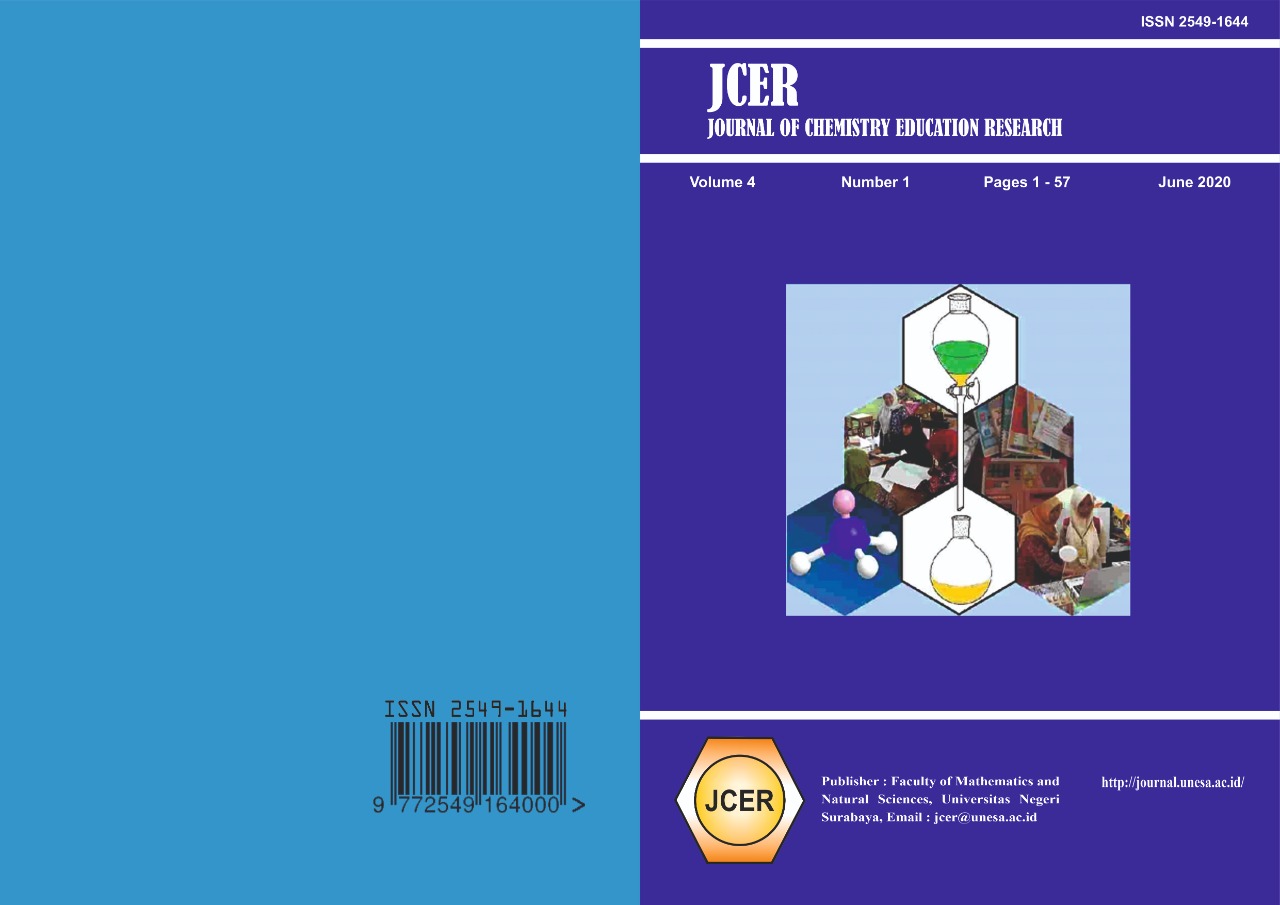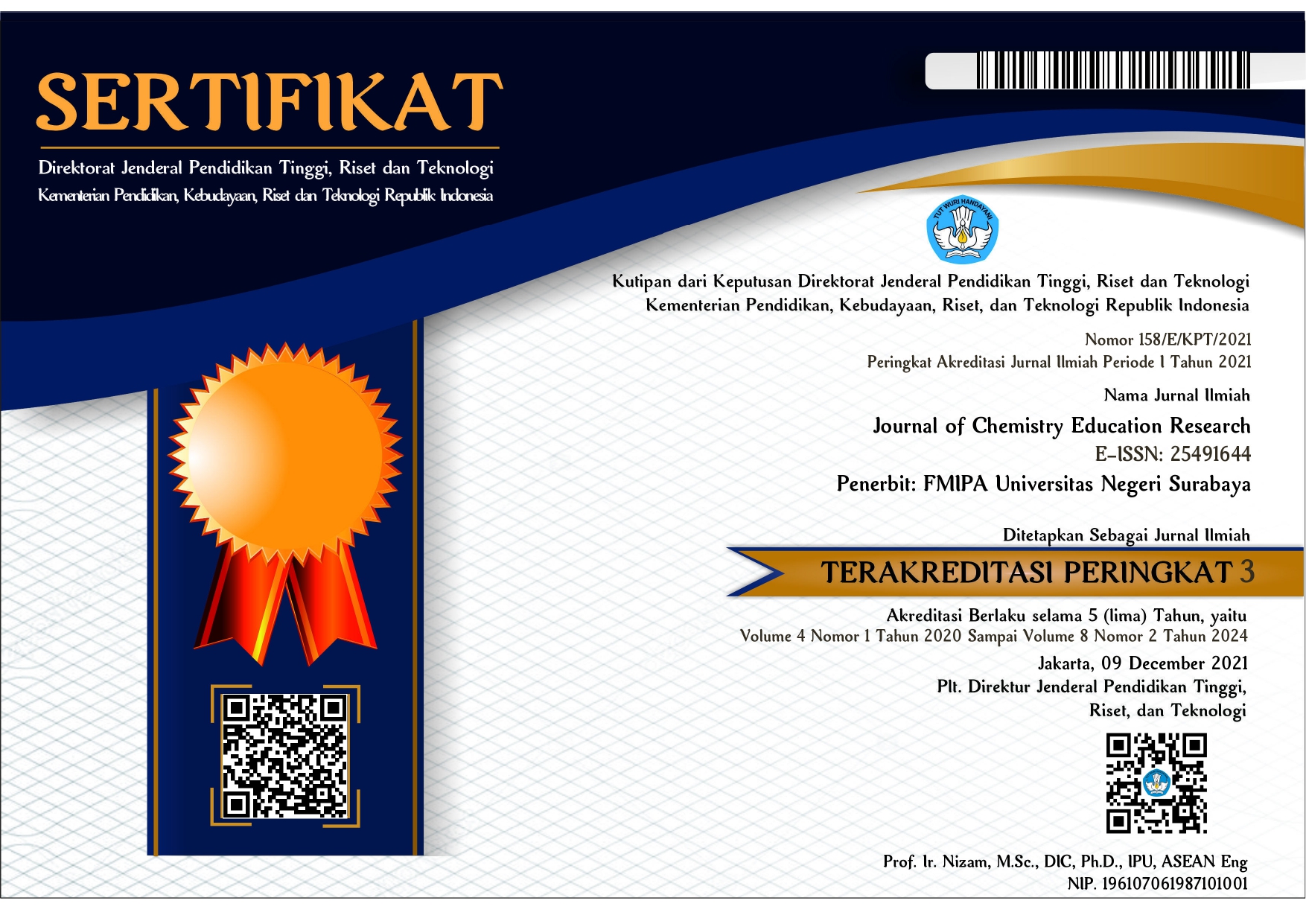DEVELOPMENT OF ETHNOSAINS-BASED LEARNING MODULE THEME ACID AND BASE FOR SENIOR HIGH SCHOOL CLASS XI
DOI:
https://doi.org/10.26740/jcer.v4n1.p16-22Keywords:
Module, Ethnoscience, Culture, Acid, BaseAbstract
This research-based on decreasing cultural identity because of the process of globalization and limited modules used in learning that integrated with culture. This research aims to determine the validity of ethnoscience based learning modules with the theme of acids and bases and to find out the response of class XI students to the modules used. The research method is Research and Development (R&D) which includes several stages: problem identification, data collection, design module, design validation, design revisions, small-scale trials, and final module. The results showed that the modules developed according to BSNP valid with Aiken calculations for aspects of content and media were 0.99 and 0.97. As for the responses of students in the high, medium and low groups, and the percentage 92%, 93%, and 92% which are included in the category very good. The developed module has proven valid to use in learning.References
[1] Sudarmin, & Sumarni, W. 2018. œIncreasing character value and conservation behavior through integrated ethnoscience chemistry in chemistry learning: A Case Study in The Department of Science Universitas Negeri Semarang.IOP Publishing, 349(1),h. 1-8.
[2] Rahmawati, Y., Ridwan, A., & Nurbaity. 2017. œShould we learn culture in chemistry classroom? Integration ethnochemistry in culturally responsive teaching.American Institute of Physics, 1868(1),h. 1-11.
[3] Majid, A., & Rohman, C. 2014. Pendekatan Ilmiah dalam Implementasi Kurikulum 2013. Bandung: PT. Remaja Rosdakarya.
[4] Sudarmin. 2015. Pendidikan Karakter, Etnosains dan Kearifan Lokal (Konsep dan Penerapannya dalam Penelitian dan Pembelajaran Sains). Semarang: FMIPA UNNES.
[5] Rahayu, Y., & Sudarmin. 2015. œPengembangan Modul IPA Terpadu Berorientasi Etnosains Tema Energi dalam Kehidupan untuk Menanamkan Jiwa Konservasi Peserta Didik.Unnes Science Educational Journal, 4(2),h. 919-926.
[6] Khotim, H. N., Nurhayati, S., & Hadisaputro, S. 2015. œPengembangan modul kimia berbasis masalah pada materi asam basa.Chemistry in Education, 7(3), h.63-69.
[7] Rosyidah, A. N., Sudarmin, & Siadi, K. 2013. œPengembangan modul ipa berbasis etnosains zat aditif dalam bahan makanan untuk kelas viii smp negeri 1 pegandon Kendal.Unnes Science Education Journal, 2(1),h. 133-139.
[8] Setiawan, B., & Sudarmin. 2017. œThe development of local wisdom-based natural science module to improve science literation of students. Jurnal Pendidikan IPA Indonesia, 6(1),h. 49-54.
[9] Sujarwo, W., & Caneva, G. 2015. œEthnobotanical Study of Cultivated Plants in Home Gardens of Traditional Villages in Bali (Indonesia).Springer, 43(5),h. 769-778.
[10] Nurmayulis, & Hermita, N. 2015. œPotensi tumbuhan obat dalam upaya pemanfaatan lahan pekarangan oleh masyarakat desa cimenteng kawasan taman nasional ujung kulon.Jurnal Agrologia, 4(1),h. 1-7.
[11] Haq, G. I., Permanasari, A., & Sholihin, H. 2010. œEfektivitas penggunaan sari buah jeruk nipis terhadap ketahanan nasi.Jurnal Sains dan Teknologi Kimia, 1(1),h. 44-58.
[12] Hakim, R. F., Fakhrurazi, & Editia, A. 2018. œPengaruh perasan air jeruk nipis (citrus aurentifolia) terhadap pertumbuhan bakteri lactobacillus acidophilus. Journal of Syiah Kuala Dentistry Society, 3(1),h. 1-3.
[13] Syafaati, D. A., & Nashrudin, H. 2018. œImplementasi model pembelajaran POGIL untuk melatihkan keterampilan berpikir kritis siswa pada materi asam basa kelas xi sman 18 surabaya. UNESA Journal of Chemistry Education, 7(3),h. 250-256.
[14] Sanjaya, W. 2013. Penelitian Pendidikan (Jenis, Metode dan Prosedur). Jakarta: Kencana.
[15] Sugiyono. 2007. Metode Penelitian Pendidikan Pendekatan Kuantitatif, Kualitatif, dan R&D. Bandung: Alfabeta
[16] Aiken. 1985. œThree coefficients for analyzing the reliability and validity of ratings. Sage Journals,h.131-142.
[17] Ratnawati, H. 2016. œAnalisis Kuantitatif Instrumen Penelitian (Panduan Peneliti, Mahasiswa, dan Psikometrian). Yogyakarta: Purnama Publishing.
[18] Riduwan. 2010. Dasar-dasar Statistik. Bandung: Alfabeta.
[19] Daryanto. 2013. Menyusun Modul Bahan Ajar untuk Persiapan Guru dalam Mengajar. Yogyakarta: Gava Media.
[20] BSNP. 2018, Juni 2. Instrumen Penilaian Buku Teks Pelajaran. Diambil dari www.bsnp-indonesia.org.
[21] Undang-Undang Republik Indonesia Nomor 20. 2003. Sistem Pendidikan Nasional. Jakarta: Departemen Pendidikan Nasional Republik Indonesia.
[22] Sudarmin, & dkk. 2017. œDevelopment of Ethnoscience Approach in The Module Theme Substance Additives to Improve the Cognitive Learning Outcome and Students entrepreneurship.Journal of Physics, 824(1),h. 1-15.
[2] Rahmawati, Y., Ridwan, A., & Nurbaity. 2017. œShould we learn culture in chemistry classroom? Integration ethnochemistry in culturally responsive teaching.American Institute of Physics, 1868(1),h. 1-11.
[3] Majid, A., & Rohman, C. 2014. Pendekatan Ilmiah dalam Implementasi Kurikulum 2013. Bandung: PT. Remaja Rosdakarya.
[4] Sudarmin. 2015. Pendidikan Karakter, Etnosains dan Kearifan Lokal (Konsep dan Penerapannya dalam Penelitian dan Pembelajaran Sains). Semarang: FMIPA UNNES.
[5] Rahayu, Y., & Sudarmin. 2015. œPengembangan Modul IPA Terpadu Berorientasi Etnosains Tema Energi dalam Kehidupan untuk Menanamkan Jiwa Konservasi Peserta Didik.Unnes Science Educational Journal, 4(2),h. 919-926.
[6] Khotim, H. N., Nurhayati, S., & Hadisaputro, S. 2015. œPengembangan modul kimia berbasis masalah pada materi asam basa.Chemistry in Education, 7(3), h.63-69.
[7] Rosyidah, A. N., Sudarmin, & Siadi, K. 2013. œPengembangan modul ipa berbasis etnosains zat aditif dalam bahan makanan untuk kelas viii smp negeri 1 pegandon Kendal.Unnes Science Education Journal, 2(1),h. 133-139.
[8] Setiawan, B., & Sudarmin. 2017. œThe development of local wisdom-based natural science module to improve science literation of students. Jurnal Pendidikan IPA Indonesia, 6(1),h. 49-54.
[9] Sujarwo, W., & Caneva, G. 2015. œEthnobotanical Study of Cultivated Plants in Home Gardens of Traditional Villages in Bali (Indonesia).Springer, 43(5),h. 769-778.
[10] Nurmayulis, & Hermita, N. 2015. œPotensi tumbuhan obat dalam upaya pemanfaatan lahan pekarangan oleh masyarakat desa cimenteng kawasan taman nasional ujung kulon.Jurnal Agrologia, 4(1),h. 1-7.
[11] Haq, G. I., Permanasari, A., & Sholihin, H. 2010. œEfektivitas penggunaan sari buah jeruk nipis terhadap ketahanan nasi.Jurnal Sains dan Teknologi Kimia, 1(1),h. 44-58.
[12] Hakim, R. F., Fakhrurazi, & Editia, A. 2018. œPengaruh perasan air jeruk nipis (citrus aurentifolia) terhadap pertumbuhan bakteri lactobacillus acidophilus. Journal of Syiah Kuala Dentistry Society, 3(1),h. 1-3.
[13] Syafaati, D. A., & Nashrudin, H. 2018. œImplementasi model pembelajaran POGIL untuk melatihkan keterampilan berpikir kritis siswa pada materi asam basa kelas xi sman 18 surabaya. UNESA Journal of Chemistry Education, 7(3),h. 250-256.
[14] Sanjaya, W. 2013. Penelitian Pendidikan (Jenis, Metode dan Prosedur). Jakarta: Kencana.
[15] Sugiyono. 2007. Metode Penelitian Pendidikan Pendekatan Kuantitatif, Kualitatif, dan R&D. Bandung: Alfabeta
[16] Aiken. 1985. œThree coefficients for analyzing the reliability and validity of ratings. Sage Journals,h.131-142.
[17] Ratnawati, H. 2016. œAnalisis Kuantitatif Instrumen Penelitian (Panduan Peneliti, Mahasiswa, dan Psikometrian). Yogyakarta: Purnama Publishing.
[18] Riduwan. 2010. Dasar-dasar Statistik. Bandung: Alfabeta.
[19] Daryanto. 2013. Menyusun Modul Bahan Ajar untuk Persiapan Guru dalam Mengajar. Yogyakarta: Gava Media.
[20] BSNP. 2018, Juni 2. Instrumen Penilaian Buku Teks Pelajaran. Diambil dari www.bsnp-indonesia.org.
[21] Undang-Undang Republik Indonesia Nomor 20. 2003. Sistem Pendidikan Nasional. Jakarta: Departemen Pendidikan Nasional Republik Indonesia.
[22] Sudarmin, & dkk. 2017. œDevelopment of Ethnoscience Approach in The Module Theme Substance Additives to Improve the Cognitive Learning Outcome and Students entrepreneurship.Journal of Physics, 824(1),h. 1-15.
Downloads
Additional Files
Published
2020-06-18
Issue
Section
Articles
 Abstract views: 609
,
Abstract views: 609
, PDF Downloads: 953
,
PDF Downloads: 953
, PDF Downloads: 0
,
PDF Downloads: 0
, PDF Downloads: 0
,
PDF Downloads: 0
, PDF Downloads: 0
,
PDF Downloads: 0
, PDF Downloads: 0
,
PDF Downloads: 0
, PDF Downloads: 0
PDF Downloads: 0



